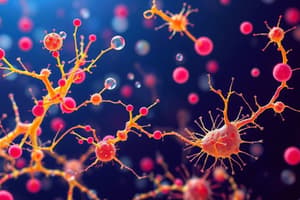Podcast
Questions and Answers
What is the primary role of ribosomes in bacterial cells?
What is the primary role of ribosomes in bacterial cells?
Ribosomes are the site of protein synthesis in bacterial cells.
Describe the nucleoid in a bacterial cell.
Describe the nucleoid in a bacterial cell.
The nucleoid contains the genetic information of a bacterial cell in a single circular molecule of double-stranded DNA.
What distinguishes plasmids from the nucleoid in bacterial cells?
What distinguishes plasmids from the nucleoid in bacterial cells?
Plasmids are extrachromosomal, circular DNA molecules that replicate independently of the nucleoid.
Explain what function the bacterial cell wall serves.
Explain what function the bacterial cell wall serves.
Signup and view all the answers
How does electron microscopy contribute to our understanding of bacterial structures?
How does electron microscopy contribute to our understanding of bacterial structures?
Signup and view all the answers
What distinguishes eukaryotic cells from prokaryotic cells in terms of structure?
What distinguishes eukaryotic cells from prokaryotic cells in terms of structure?
Signup and view all the answers
Describe the size range of bacterial cells and provide the unit of measurement.
Describe the size range of bacterial cells and provide the unit of measurement.
Signup and view all the answers
What are the main bacterial shapes and how do they differ?
What are the main bacterial shapes and how do they differ?
Signup and view all the answers
Explain the relationship between bacterial cell division and cell arrangement.
Explain the relationship between bacterial cell division and cell arrangement.
Signup and view all the answers
What is the role of viruses in relation to host cells?
What is the role of viruses in relation to host cells?
Signup and view all the answers
Study Notes
Microbiology
- Study of microscopic organisms
- Single-celled organisms or microbes
- Microbial cells carry out all functions to maintain themselves and reproduce
- Microorganisms are either Eukaryotes (e.g. fungi) or Prokaryotes (e.g. bacteria)
Eukaryotes vs Prokaryotes
-
Eukaryotes
- Larger in size
- Have a distinct nucleus surrounded by a nuclear membrane
- Have enclosed organelles, like mitochondria
- Examples include fungi
-
Prokaryotes
- Smaller in size
- No nucleus
- Lack enclosed organelles
- Examples include bacteria
Viruses
- Smallest of the infective agents
- Lack cell structure
- Obligate intracellular parasites, relying on host cells for replication and survival
General Bacteriology
Morphology of Bacterial Cell
- Size: Measured in micrometers (µm), range from 0.2-1.2 µm in width and 0.4-14 µm in length
-
Shape
- Cocci: spherical or round
- Bacilli: rod-shaped
- Spiral: twisted or curved
- Some bacteria are pleomorphic, meaning they have variable shapes
-
Arrangement: How bacteria group together
-
Cocci
- Pairs (diplococci)
- Chains (streptococci)
- Irregular clusters (staphylococci)
-
Bacilli
- Pairs
- Chains
- No special arrangement
-
Cocci
-
Staining
- Different bacteria stain differently with dyes, providing information about their cell wall structure
-
Motility
- Flagella: enable bacteria to move
- Pili (Fimbriae): short hair-like structures assisting in attachment to surfaces
- Capsule: Extracellular layer protecting bacteria and aiding in attachment
Bacterial Structures
-
Bacterial Coats
-
Cell Membrane
- Innermost layer, composed of a phospholipid bilayer
- Differs from eukaryotic cell membranes by lacking sterols
- Functions include transport of molecules, excretion of enzymes, respiration, and cell division
-
Cell Wall
- Surrounds the cell membrane, providing structural support and rigidity
- Composed of peptidoglycan, a unique molecule that bacteria walls are made of
- Gram-positive and Gram-negative bacteria differ in the composition of their cell walls
- Functions include maintaining shape, resisting osmotic pressure, playing a role in cell division, and determining staining characteristics
- Wall-deficient variants: Mycoplasma, which lack a cell wall, are naturally resistant to cell wall inhibitors like penicillins
-
Capsule
- Extracellular layer made of polysaccharides
- Forms in the host environment (in-vivo)
- Functions include adherence to host tissues, contributing to virulence, and aiding in identification
-
Cell Membrane
-
Cytoplasmic Structures
-
Nucleoid
- Contains the genetic information of the bacteria cell
- Single circular molecule of double-stranded DNA
- Supercoiled to fit inside the cell
-
Plasmids
- Extrachromosomal DNA molecules
- Can be present in some bacteria
- Replicate independently of the chromosome
-
Ribosomes
- Sites of protein synthesis
- Composed of protein and RNA
- Smaller in prokaryotes than in eukaryotes
- Antibiotics can target this difference
-
Inclusion Granules
- Store nutrients, such as phosphates, sulfur, and carbohydrates
-
Nucleoid
-
External Appendages
-
Flagella
- Enable movement
- Help in chemotaxis: movement towards nutrients or away from harmful substances
- Location and number vary by bacterial species
-
Pili (Fimbriae)
- Protein tubes extending from the cell
- Shorter and thinner than flagella
- Functions:
- Adherence to surfaces
- Conjugation: transfer of DNA between bacteria via a specialized pilus (sex pilus)
-
Flagella
Bacterial Spores
- Formed by bacteria of the genera Bacillus and Clostridium
- Highly resistant resting phase
- Not actively growing or reproducing
- State of dormancy
Studying That Suits You
Use AI to generate personalized quizzes and flashcards to suit your learning preferences.
Related Documents
Description
Explore the fascinating world of microbiology, focusing on the characteristics and classifications of microscopic organisms. This quiz covers key topics such as eukaryotes, prokaryotes, viruses, and the morphology of bacterial cells. Test your knowledge and deepen your understanding of these essential life forms.




